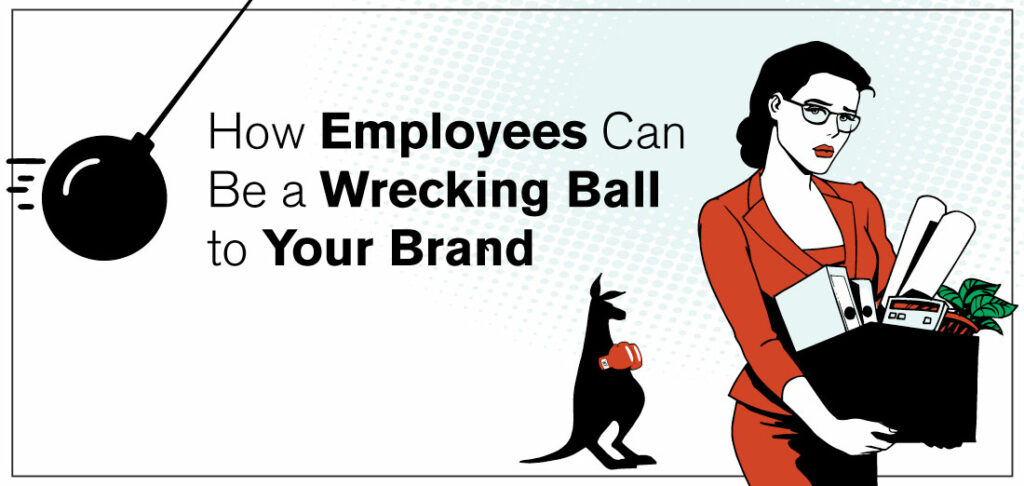Layoffs, firings, and low morale are inevitable. If prevented, however, a brand could save itself a lot of business. Every year, companies lay off thousands of employees due to restructuring, shrinking revenues, or a sluggish economy. But what about all the lost revenue that comes from that?
Improved hiring practices and developing happy employees are just a couple of solutions. (For more on those topics, click the links!)
According to 24/7 Wall Street, the top ten largest layoffs from last year totaled 57,203.
General Electric: 12,000
Macy’s: 10,000
Cognizant Technology Solutions Corporation: 6,000
JcPenny: 5,500
HHGregg: 5,000
State Farm: 4,200
Fluor Corporation (construction): 4,003
The Limited: 4,000
Eli Lilly and Company: 3,500
Wet Seal: 3,000
I’d say it’s a safe assumption that when a company goes through mass layoffs or someone is fired from a company, there’s going to be some general resentment. Will those employees continue to buy General Electric products? Will they return to Macy’s for shirts and shoes? Will they praise their time at Cognizant Technology Solutions Corporation? I would guess not, at least not for a period of time immediately after being let go or fired.
Imagine that each employee would have spent $15 a month at the company they worked at (a low-ball guess indeed!). That would mean, considering the laid-off employees aren’t using the services of their former employer or buying anything from them any longer, that would be $858,045 in lost revenue between the 10 companies. For General Electric, that’s a drop in the bucket, probably one of their factory’s monthly electric bill. But what if each former employees’ partner or a close friend decides not to buy GE’s products out of protest or just general disdain for the company because they let go of someone close to them? That feeling could run into extended family or a second friend as the former employee goes on about how crummy of a company they are for the layoffs. Things could start to multiply.
While 2017 WebPunch stats show that 41% of consumers use online reviews to make a purchasing decision, nearly 37% of consumers choose a brand based off what their friends and family are telling them.
In other words, every time a brand has to lay off a chunk of their employees or are even forced to fire them, that brand’s reputation may be at risk. Smaller businesses like mom-and-pop stores or franchise locations may be at an even greater risk. The negative repercussions of laying off or firing a handful of employees could have rippling effects in the immediate community.
Then there’s a brand’s working employees. Are they happy with their work? Are they happy with management and the company as a whole? Do internal operations reflect the public message?
If the answer is no to any of these questions, those too could have similar effects on a brand’s reputation like that of firings or layoffs. Those disgruntled employees may be talking nasty to their friends and family about the brand—most likely they are.
Even worse, they could be talking badly about the brand online whether it’s on their own social media outlets or on employee review sites like glassdoor.com and indeed.com.
On employee review sites, an employee can post an anonymous review about what it’s like working for their employer. If it’s negative, all the world can see the review. As a result, consumers know that their public image may not align with its internal motto, possibly deterring future sales. At the same time, negative employee sentiment may also make it challenging to hire top-tier employees.
What’s the solution to it all? First off, make sure to hire employees as needed to avoid layoffs and make sure they are a good fit for the company to ensure that you won’t have to fire them down the road.
Here’s a personal story: I worked at an up-and-coming coffee shop in Brooklyn, NY some years ago. I was hired on as a barista, but quickly set on a managerial track as the company was expected to expand dramatically over the coming months. After just a few weeks of working there—with no negative marks, I might add—I was laid off because they had over hired. Now every time I talk about that shop and my time working there, I always mention that story. It’s not an awful story by any means, but one that may stick and has definitely stuck with me.
And what about that employee sentiment? That is important! The process is similar to turning detractor customers into promoters: Develop an internal survey to gauge how your workforce feels about the working environment and management. Take that feedback to heart and analyze what it means to your company and what changes may need to be made. Then, take it a step further by asking those employees who really enjoy working for you to review the brand on an employee review site.
Layoffs, firing, or just crummy workplace. They can all hinder a brand’s online reputation. Online reviews and and talking to friends and family are where people go to both praise and gripe about a company, albeit humans tend to spend more time in the griping department, especially when it’s about an experience they’ve had with a business (nudge, nudge—Yelp!).
As a brand owner or manager, you have the power to positively guide the conversation that both your customers and employees are having about your brand. Make it shine!

Matthew Van Deventer is a content creator for WebPunch. As a dealer of words he dabbles in journalism and loves a good story, whatever the medium. Matthew lives outside of Denver, CO with his wife, daughter, and pup, Chewy.


